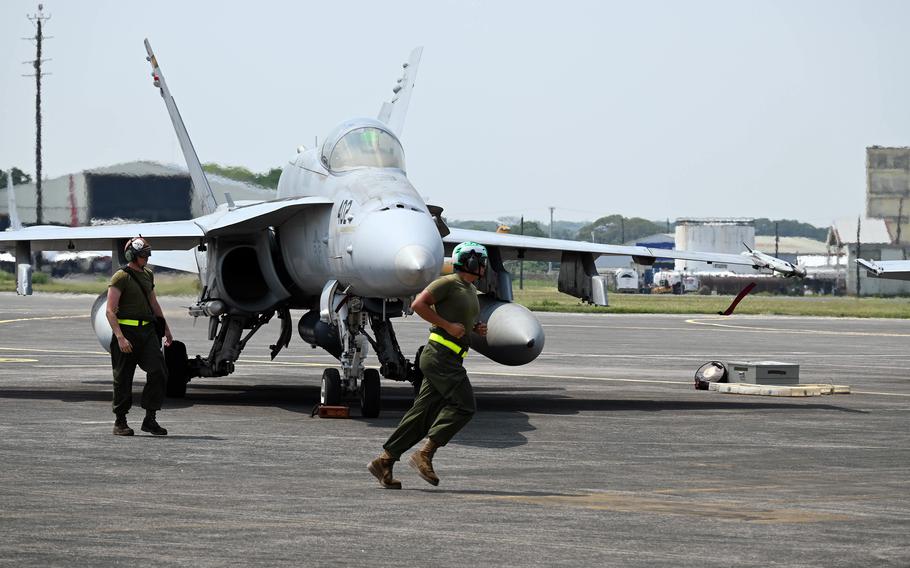
Ground crew prepare an F/A-18 Hornet with Marine Fighter Attack Squadron 323 for takeoff during a Balikatan drill at Clark Air Base, Philippines, April 24, 2025. (Seth Robson/Stars and Stripes)
CLARK AIR BASE, Philippines — U.S. and Philippine multirole fighter jets are preparing to destroy warships during annual drills in the Philippines, amid rising tensions with Beijing in the South China Sea.
Marine Corps F/A-18 Hornets and Air Force F-16 Fighting Falcons — deployed from Marine Corps Air Station Miramar, Calif., and Misawa Air Base in northeastern Japan — are participating in Balikatan, annual combat drills that began Monday and run through May 9.
The exercise brings together approximately 9,000 American and 5,000 Filipino troops in what officials describe as a “full battle test” for island defense.
“This year’s Balikatan will showcase a full battle test, the purposeful integration of real-world security situations relevant to the region with live, virtual and constructive training,” the head of Marine Corps Forces Pacific, Lt. Gen. James Glynn, said at Camp Aguinaldo in Quezon City, according to a Naval News report Tuesday.
The drills take place amid sporadic confrontations between the Philippine and Chinese coast guards in the contested South China Sea. The two sides have repeatedly clashed over competing territorial claims in the Philippines’ exclusive economic zone.
Air Force F-16s have trained regularly in the Philippines in recent years, said Lt. Col. Josh “Vegas” Plocinski, commander of Misawa’s 14th Fighter Squadron.
“One of the bigger aspects we will be going to focus on in Balikatan is maritime strike,” he told Stars and Stripes Thursday at Clark.
In Japan, the squadron’s “Wild Weasel” mission focuses on the suppression of enemy air defenses. While the unit trains for maritime strikes in Japan, the scale of operations at Balikatan is larger, Plocinski said.
The squadron has deployed a dozen F-16s and 400 airmen to Clark. They will use modified 2,000-pound GPS-guided bombs during maritime strike missions, he said.
Maritime strike isn’t the Hornets’ primary mission, but it’s within their capability, said Marine Aircraft Group 39 commander, Col. Jeremie “Hank” Hester, an AH-1 Cobra attack helicopter pilot who is overseeing nearly 1,000 Marines during the exercise.
The Marines, deployed from California, are operating from facilities spread from northern Luzon to Palawan, he told Stars and Stripes at Clark.
Eight Hornets from Marine Fighter Attack Squadron 323 are at the base. Also in the Philippines are six MV-22B Ospreys from Marine Medium Tiltrotor Squadron 364 at Camp Pendelton, Calif., Hester said.
The Philippine air force has previously used its FA-50s — South Korean-made, supersonic jets — at Balikatan. During the 2023 drills, an FA-50 successfully launched a missile strike on a mock target vessel, according to the state-run Philippine News Agency.
Manila is preparing to upgrade its fighter fleet. In March, the U.S. Department of Defense approved $5.58 billion sale of 20 Lockheed Martin F-16 Block 70/72 fighters — 16 single-seat C models and four dual-seat D models.
The Block 70/72 is an advanced fourth-generation fighter but lacks the stealth capabilities of fifth-generation aircraft like the F-22 Raptor and F-35 Lightning II.
Meanwhile, the U.S. has invested heavily in bolstering the Philippines’ military structure. Billions of dollars have gone toward modernizing runways and support facilities at Cesar Basa Air Base, just south of Clark and home to the Philippine’s 5th Fighter Wing, which flies the FA-50.
F/A-18s and F-16s are versatile fighters capable of air-to-air and air-to-ground combat, said Ralph Cossa, former president of the Pacific Forum think tank in Hawaii.
“They would be good for defending or attacking islands or ships at sea, as well as land-based targets,” he told Stars and Stripes by email Thursday.
The potential acquisition of F-16s is a long-overdue step that would significantly enhance the Philippines’ defensive and offensive capabilities, Cossa said.
“It demonstrates an increased willingness and capability to defend themselves and the U.S. willingness to help them do so,” he wrote.
While the Philippines is unlikely to be directly involved in a conflict over Taiwan, Manila would benefit from having “some firepower of its own to lend” if a simultaneous flare-up occurs in the South China Sea, he said.